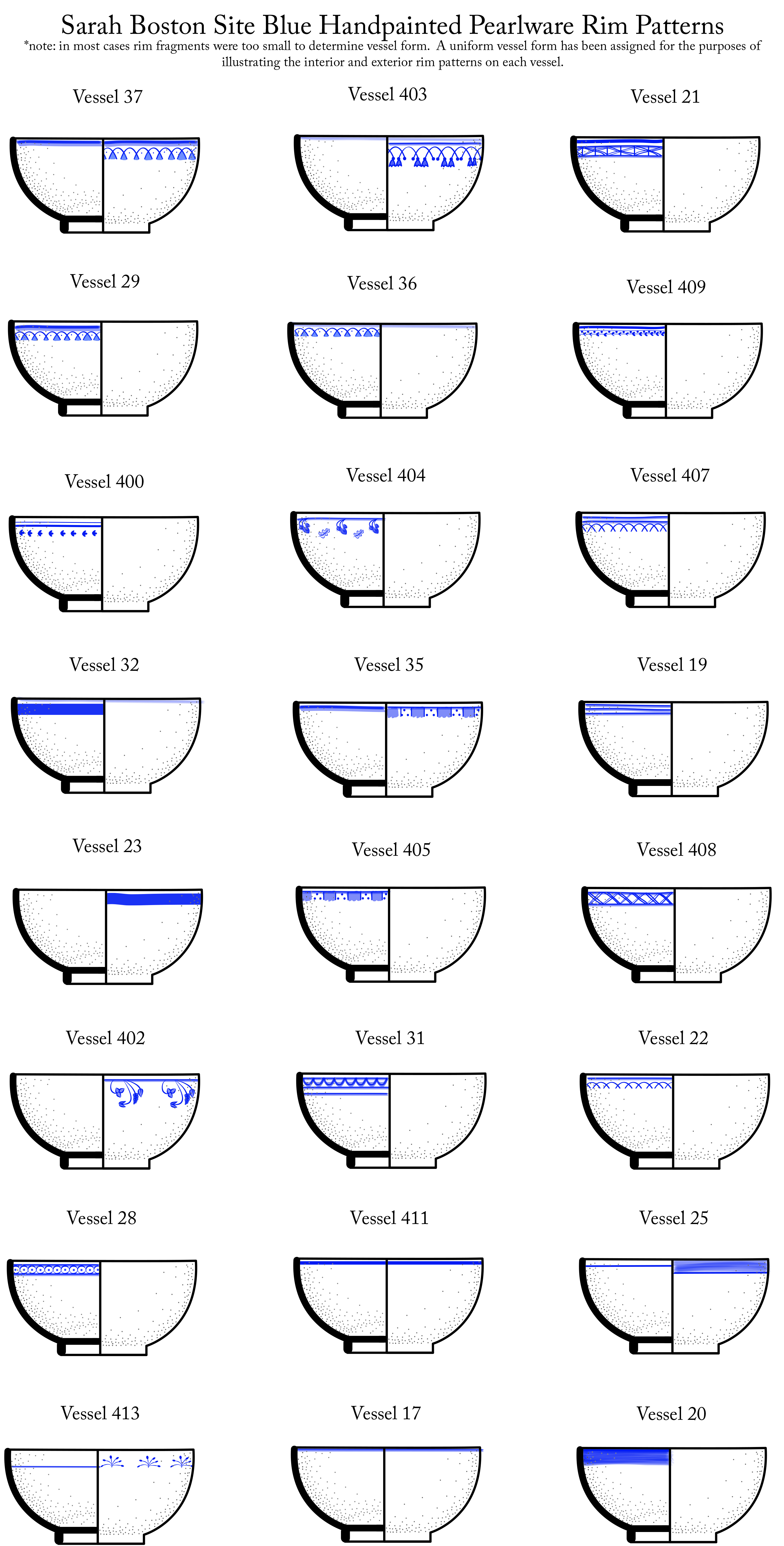Last winter, I put together a minimum vessel count for the blue handpainted pearlware from the Sarah Boston Farmstead assemblage. We decided to take on this task as a test to determine if in fact it would be possible to mend the ceramic collection into distinguishable vessels. We chose the blue handpainted pearlware in part because it seemed like a manageable segment of the greater ceramic assemblage, and also because we assumed ceramics with linear patterns and paint strokes would be easier to refit than say, plain white, or transfer print pieces. What we found was a little disappointing at first. We were unable to reconstruct a single vessel in the blue handpainted pearlware category. However, we were able to reconstruct enough of several rim fragments to start to
put together a catalog of all the blue handpainted rim patterns in the collection. While maybe not as exciting as entire vessels, we thought you might enjoy seeing these patterns.As it turns out, the majority of blue handpainted pearlware rims fell into a category of ceramic glaze called, “china glaze”, a popular style of English-made refined white earthenware made between 1775-1812 (www.chipstone.org). These vessels were covered in a blue tinted glaze and painted with imitation Chinese patterns popularized by the more expensive Chinese porcelain they were meant to reference (www.jefpat.org).
This brings up an interesting question, and one that I think is very relevant for our work on the Sarah Boston Site in general: can an English ceramic, with Chinese decoration, have meaning for a Nipmuc family? The answer, as you might have guessed, is: of course it can! What we are seeing here is the entanglement of global influences (English clay and ceramic technology, Chinese styling, Native aesthetic preferences) in one local knot. This is the kind of thing we encounter all the time when we study the material dimensions of colonialism. The fact that Sarah and her mother participated in the consumption of English ceramics and Chinese patterns shouldn’t surprise us, after all, Sarah Boston and her mother Sarah Burnee didn’t experience colonialism in a vaccuum, rather, they were a part of the early American experience, buying dishes and fabric and other goods that expressed their style and preferences, just like everyone else. That didn’t make them any less engaged or involved with their Nipmuc heritage, rather it’s interesting to think about how their Nipmuc identities may have informed some of their consumer choices.

This is a common representation standard in archaeology. The right side of the vessel is an illustration of the exterior, the left is an illustration of the cross-section of the vessel and the interior.
by: Heather Law Pezzarossi


February 8, 2013 at 2:04 PM
I’m curious as to whether you’ve encountered any slip-decorated examples with blue painted Chinoiserie rims. My primary interest is dipped wares but am intrigued by the above combination. The only known British factory archaeological site to have revealed this feature is the William Greatbatch site in Staffordshire in the 1775-1782 deposition.
February 12, 2013 at 2:07 PM
Great blog posting! I have posted it in my Ceramics in America Facebook page.
A couple of comments that may help move us towards a better contextual understanding of these wares.
Keep in mind that the English China glaze industry was intent on copying English porcelain…not directly from Chinese imports. In other words, it is important to understand the evolution of English porcelain as it related to appropriated Chinese styles and designs.
The other is that in this period..there were several styles competing for consumer’s hearts and minds…Chinoiserie, Neoclassical, and Fancy. As Jonathan Rickard’s requests indicates…sometimes elements of all three might be found in a single ceramic object. It is also important to recognized that virtually EVERY household in an American context during the 1780-1810 period had chinoiserie decorated earthenware. I would love to hear of an archaeological site that did not!
Finally, I would think you could identify vessel forms from these small rim forms…The small sherd you illustrate clearly comes from a saucer.
Keep up the good work!!!
February 13, 2013 at 6:44 AM
I have three ceramic vessels with a pattern similar to your vessel 36. One is from an Indian cabin and animal compound (1812-ca. 1832), a Euro-American farmstead (1831-1839), and a French-Canadian house and blacksmith shop (1789-1867). Are there any published or unpublished reports on the Sarah Boston Farmstead?
February 13, 2013 at 2:37 PM
Thanks for your comments, it means a lot to us to have your input!
February 13, 2013 at 2:38 PM
I don’t think so. We have lots of slip decorated, but no evidence that any had this kind of rim deco. Thanks for your interest!
February 13, 2013 at 2:42 PM
Thanks for your interest, we have two reports online through the Fiske Center for Archaeological Research’s web page.
November 25, 2015 at 9:55 AM
Hi have you done a similar analysis of the feather edged/shell edged hand painting on the rim edges and marlys of pearlware plates?
September 25, 2019 at 4:21 PM
I have 3 sherds of your vessel 22 rim pattern, apparently saucers, from the San Diego Presidio. I’m very interested in your report. Are any of you rim sherds connected to central patterns?